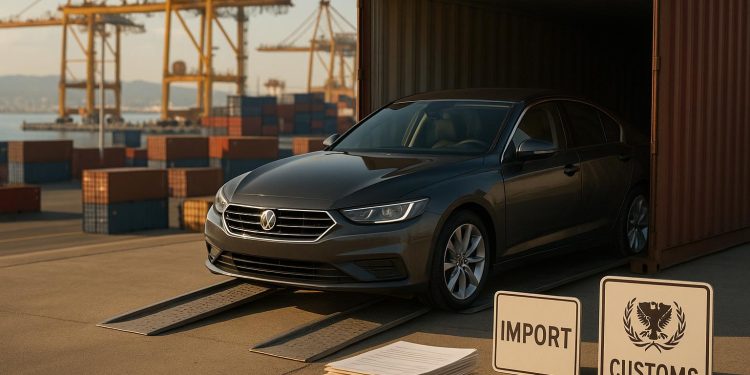Importing a car into South Africa is a detailed process, requiring strict adherence to government regulations and precise documentation. Here’s what you need to know:
- Eligibility: Only certain individuals, like returning residents, new permanent residents, diplomats, and racing drivers, can import cars. Restrictions apply to used passenger vehicles and left-hand drive models.
- Required Documents: Key permits include the Import Permit (from ITAC) and the Letter of Authority (LOA) (from NRCS). Additional paperwork includes proof of ownership, customs clearance documents, and a roadworthiness certificate.
- Costs: Expect 30% customs duty on the car’s value, 15% VAT, and potential ad valorem taxes. Other expenses include shipping, insurance, and inspection fees.
- Process: Secure permits before shipping, choose a reliable shipping partner, and prepare the car for customs clearance. Afterward, ensure it meets South African standards and complete registration.
- Avoid Delays: Double-check all documents, hire experts if needed, and stay updated on regulation changes via SARS and ITAC.
Key takeaway: Proper planning, accurate documentation, and understanding all costs upfront can help you avoid delays and unexpected expenses when importing a car into South Africa.
Ship Car to South Africa | Everything You Need to Know About Importing a Car to RSA
Who Can Import Cars and What Restrictions Apply
Importing a vehicle into South Africa comes with a set of rules and conditions, largely aimed at protecting the local automotive industry. Whether you’re eligible depends on your personal circumstances, and the process often involves specific documentation. Here’s a breakdown of who qualifies and the restrictions you might face.
Who Qualifies to Import Vehicles
- Returning South African Residents: If you’ve lived abroad for at least six months, you can bring up to three vehicles registered in your name. However, you must keep the car for at least two years after importation.
- New Permanent Residents: You can import vehicles registered in your name before moving to South Africa. Similar to returning residents, you must retain the vehicle for at least two years. Duty exemptions may apply if you’ve owned and used the car for at least 12 months before shipping.
- Foreign Diplomats: Vehicles can be imported duty- and tax-free with a valid diplomatic clearance certificate and proof of the vehicle’s value.
- Racing Drivers: South African racing drivers can bring in racing cars exclusively for track events. This requires a Motorsport South Africa (MSA) competition license and an affidavit confirming the car won’t be sold for two years.
- Disabled Individuals: South African citizens with disabilities can import specially modified vehicles to suit their needs. A medical certificate is required, and the vehicle must not be sold within two years of importation.
Vehicles that fall outside these categories are subject to stricter regulations and may not qualify for import.
Banned Vehicles and Special Cases
- Left-Hand Drive Vehicles: These are generally prohibited on South African roads unless they were registered in the current owner’s name in South Africa before January 1, 2000, with a clear ownership history.
- Used Passenger Vehicles: Most used passenger vehicles that don’t meet specific eligibility criteria are banned to protect the local automotive market.
- Motorcycles: Unlike cars, used motorcycles are easier to import since they aren’t manufactured locally. You’ll need to complete Form IE463 and provide detailed information about the motorcycle, including its engine capacity.
- Classic Cars: Vehicles over 20 years old face a 20% customs duty, while those older than 25 years are often exempt from certain regulations.
"Vehicles over 25 years old are typically exempt from some of the stringent import regulations, particularly those concerning left-hand drive configurations. These cars are often considered works of art, pieces of history that enrich the cultural tapestry of our roads." – Classic Transport
- Collector’s Items: Cars over 40 years old or those recognized as collector’s items may qualify for a full duty rebate under Rebate Item 460.17/87.03/04.04 of the Customs and Excise Act. Consulting experts like the South African Veteran and Vintage Association can help confirm a vehicle’s status.
- Inherited Vehicles: Special permits allow for the import of inherited vehicles. You’ll need Form IE463, along with the deceased person’s documents, their will, and a death certificate.
Why These Restrictions Exist
South Africa’s import restrictions aim to support the local automotive manufacturing industry and maintain road safety standards. By limiting imports to specific situations, the government protects domestic production and ensures vehicles on the road meet safety requirements.
Uncontrolled imports could disrupt the local market, affecting jobs and sales in the automotive sector. The ban on left-hand drive vehicles is a safety measure, as right-hand drive vehicles are better suited to South Africa’s left-side driving system.
If you’re planning to import a vehicle, make sure you confirm your eligibility and gather the necessary paperwork. Regulations can change, so stay informed by consulting the South African Revenue Service and the Department of Trade, Industry and Competition.
Required Documents and Permits
Shipping a car to South Africa involves more than just arranging transportation. You’ll need to ensure you have the correct documentation and permits to comply with South African import regulations. This process starts before your car even leaves its current location and requires proof of ownership, compliance with local standards, and government-issued authorizations.
Documents You’ll Need
Two key permits are mandatory for importing a vehicle into South Africa:
- Import Permit: Issued by the International Trade Administration Commission (ITAC), this authorizes your car’s entry into the country.
- Letter of Authority (LOA): Provided by the National Regulator for Compulsory Specifications (NRCS), this confirms your vehicle meets South African safety and emission standards.
In addition to these permits, you’ll need to provide identification and proof of your status. For example:
- South African citizens living abroad must submit their South African ID or passport, a letter from their employer confirming permanent employment abroad (including employment dates), and a certified copy of the car’s foreign registration.
- Permanent residents need their South African permanent residence certificate, foreign passport, foreign motor vehicle registration, and proof of study or research (if applicable).
For customs clearance, you’ll also need the following:
- Purchase Invoice: Verifies ownership and the car’s value.
- Bill of Lading: A shipping document required for customs.
- Foreign Registration Documents: Confirms the car’s registration in its country of origin.
Once the car arrives, it must pass a roadworthiness inspection at an approved testing station in South Africa. This ensures the vehicle meets local safety standards before it can be registered for road use.
| Document/Permit | Purpose | Where to Obtain |
|---|---|---|
| Import Permit | Authorizes vehicle importation | International Trade Administration Commission (ITAC) |
| Letter of Authority (LOA) | Verifies compliance with safety and emissions standards | National Regulator for Compulsory Specifications (NRCS) |
| Purchase Invoice | Confirms ownership and value | Vehicle seller or dealer |
| Bill of Lading | Required for customs clearance | Shipping company |
| Roadworthy Certificate | Ensures the car is safe for local roads | Approved testing station in South Africa |
Getting the Permits
Timing and accuracy are everything when applying for these permits. Here’s how it works:
- Import Permit: Start by completing Form IE462 and submitting it to ITAC. Processing typically takes 4 to 5 working days, and there’s no fee for this permit.
- Letter of Authority (LOA): Submit Form LA01 to the NRCS. This takes longer – anywhere from 4 to 21 working days – and costs between ZAR300 and ZAR1,800, depending on your vehicle’s type and age.
Both permits must be in hand before shipping your car to South Africa. To be safe, plan for up to 26 working days of processing time – 21 days for the LOA and 5 days for the Import Permit – though many applications are completed faster.
Accuracy in your application is critical. Even minor errors can cause delays, leaving your car stuck at the port and potentially racking up storage fees. Double-check all details and ensure your documents match the information on your applications.
Once your car clears customs, the next step is registration. Visit your provincial licensing office with your roadworthy certificate and other required documents to complete the process. Early preparation and thoroughness can save you time and avoid unnecessary headaches, ensuring a smooth transition for your vehicle into South Africa.
Shipping and Customs Process
Once you’ve secured the necessary permits, the next step is arranging international shipping and handling customs clearance. This stage demands careful planning to ensure your vehicle reaches its destination without delays or unexpected costs. Selecting the right shipping partner and mastering logistics are key to avoiding complications at customs.
How to Pick a Shipping Company
The shipping company you choose plays a major role in ensuring a smooth and cost-efficient import process. Start by prioritizing reputation and experience when evaluating potential partners. Look for companies that specialize in vehicle shipping to South Africa and have a proven track record of handling the country’s specific requirements.
Explore options that offer both Roll-on/Roll-off (RoRo) and container shipping services. RoRo shipping is generally more budget-friendly, as your car is driven onto the ship and secured in the cargo hold. On the other hand, container shipping provides greater protection by enclosing your vehicle in a dedicated container, though it comes at a higher price.
Request quotes from multiple companies and compare their pricing, service options (e.g., door-to-port or port-to-port), and included logistics. Additionally, make sure the company has experience navigating South African customs procedures. A knowledgeable shipping partner can guide you through documentation requirements and help you avoid common mistakes that lead to delays or extra fees.
Preparing Your Car for Shipping
Properly preparing your car is essential to prevent damage during shipping and to ensure a smooth customs clearance process. Start by giving your vehicle a thorough cleaning inside and out, as customs inspections will require your car to be spotless.
Remove all personal items, especially for RoRo shipping, where loose belongings are not allowed. Reduce the fuel level to about a quarter tank and adjust other fluids, such as oil, brake fluid, and coolant, based on your carrier’s guidelines.
Take clear photographs of your vehicle from multiple angles, making sure to document any existing damage. These photos can be crucial for insurance claims if needed.
Ensure your car is in good working condition, particularly the battery, brakes, and tires, as shipping companies need to drive your vehicle on and off the vessel. If your car has any mechanical issues, either fix them beforehand or notify your carrier in advance.
Getting Through Customs
When your vehicle arrives at a South African port, it will be offloaded and stored in a bonded warehouse until customs clearance is completed.
You must declare your vehicle to SARS within 7 days for loose cargo or 28 days for containerized goods. Missing these deadlines could result in your car being moved to a State Warehouse, leading to additional complications and costs.
The customs process involves several steps: submitting the required paperwork, document assessments, calculating duties and taxes, and paying the necessary fees. During this process, SARS may conduct vehicle inspections or request further information.
Declare your vehicle’s value accurately to avoid delays caused by revaluation. If SARS determines that your declared value is inaccurate, they may reassess it, which can add weeks to the clearance process and significantly increase your costs.
Customs clearance fees can be substantial. Duties are calculated at 20% for vehicles over 20 years old and 36% for newer vehicles. Additionally, Ad Valorem duty applies to high-value or luxury cars, ranging from 0.75% to 20%. Finally, 15% VAT is charged on the total of the customs value, customs duty, ad valorem duty, and a 10% uplift.
To navigate this complex process, consider hiring a vehicle import consultant or customs clearance agent. These professionals can help you avoid common errors, such as incorrect documentation or tariff codes, that may delay clearance and increase costs. Also, register with SARS as an importer before your vehicle arrives to streamline the customs process.
Once your vehicle is "cleared" by customs – meaning all duties and taxes have been paid – it can proceed to its next destination for the final registration steps. After clearing customs, you’ll need to ensure your car meets South African standards before completing registration.
sbb-itb-09752ea
Import Costs and Tax Breakdown
When importing a vehicle, it’s essential to factor in all associated costs to avoid unexpected expenses. The total cost includes the purchase price, taxes, duties, and other fees. Understanding this breakdown will help you budget effectively before addressing local vehicle standards and registration requirements.
Taxes and Duties You’ll Pay
Imported vehicles are subject to several mandatory charges. The South African Revenue Service (SARS) imposes a 30% customs duty on the vehicle’s value. Additionally, a 15% VAT is applied to the combined total of the vehicle’s cost and shipping expenses. There’s also an ad valorem tax, which is calculated based on the vehicle’s value and engine size. To get precise estimates, it’s a good idea to check the current rates directly with SARS or use an online duty calculator for convenience.
Other Costs to Consider
On top of government-imposed taxes and duties, there are other expenses that can add to your total cost. These include:
- Shipping and insurance: Costs vary depending on the carrier and shipping method you choose.
- Customs brokerage fees: These are charged for handling the required import clearance documents with local authorities.
- Roadworthy inspection: After clearing customs, your vehicle must pass a roadworthy inspection to ensure it meets South African safety standards before registration and licensing.
Sample Cost Calculation
Let’s break it down with an example. Imagine importing a used sedan priced at $25,000 with shipping costs of $4,000:
- Customs duty: 30% of $25,000 = $7,500
- VAT: 15% of ($25,000 + $4,000) = $4,350
Additional costs, such as ad valorem tax, customs brokerage, and inspection fees, will further increase the total. To get an accurate estimate of your total landed cost, consider using an online duty calculator and requesting quotes from service providers.
Meeting South African Standards and Registration
After clearing customs and paying the necessary duties, your imported vehicle must meet South Africa’s safety and emissions standards before it can legally hit the road. This process includes obtaining official certification and completing the registration with local authorities.
Standards Your Car Must Meet
To start, your vehicle needs a Letter of Authority (LOA) from the National Regulator for Compulsory Specifications (NRCS). This document confirms that the vehicle complies with South Africa’s safety and emissions standards. The South African Bureau of Standards (SABS) issues this certification, ensuring the vehicle meets all required norms.
The cost of an LOA varies, ranging from ZAR300 to ZAR1,800 (about $16 to $97), depending on factors like the vehicle’s type and age. Without this approval, the LOA cannot be issued.
Once you have the LOA, your vehicle must pass a roadworthiness test at an authorized testing station. This test checks that the vehicle meets all safety and mechanical standards for use on South African roads. The test typically costs around ZAR200 (about $11).
How to Register Your Vehicle
After clearing the roadworthiness test, the next step is registration. Head to your local vehicle registration office with the necessary documents, including your LOA, the roadworthiness certificate, and customs clearance papers.
If your vehicle doesn’t pass the roadworthiness test on the first try, don’t worry – most testing stations offer one free retest, as long as you complete the necessary repairs and return within 14 days. Once all requirements are met, submit your paperwork along with the registration fee. The authorities will then issue your South African license plates and registration certificate.
Final Steps
After completing the registration, collect your license plates and registration certificate from the office. Be sure to keep all these documents in a safe place, as you’ll need them for future renewals or inspections.
Tips and Mistakes to Avoid
With shipping, documentation, and customs procedures already discussed, let’s focus on some practical tips and common errors to help you navigate the import process smoothly. Importing a car to South Africa can be straightforward if you sidestep common pitfalls that lead to costly delays. By following these strategies, you can save both time and money.
Best Practices for Success
To avoid unnecessary headaches, double-check every document and procedure before moving forward. Ensure that the vehicle’s VIN, make, model, and year match perfectly across all paperwork. Even a small error can delay permits and result in expensive storage fees while your car sits at the port. Fixing these issues after shipping is far more challenging and costly.
Research eligibility requirements before making any purchase. South Africa has strict rules regarding used cars and left-hand drive vehicles, which can trip up first-time importers. Knowing these restrictions ahead of time helps you avoid the disappointment of learning that your vehicle isn’t allowed into the country.
Factor in all shipping and customs costs by referencing detailed breakdowns from your service providers. Online duty calculators can help you estimate total expenses, so you won’t be caught off guard by unexpected charges.
Prepare your vehicle for shipping with care. Make sure it’s in good running condition and take detailed photos of its current state before it’s shipped. These photos can be crucial if you need to make a damage claim later.
For high-value or classic cars, consider using container shipping instead of roll-on/roll-off (RoRo) transport. While container shipping is more expensive, it offers better protection and security during transit.
Common Errors That Cause Problems
Underestimating the complexity of paperwork is a mistake many first-time importers make. Gathering all required documents in advance is essential; failing to do so can lead to delays that stretch on for weeks while you sort things out.
Incorrect tariff classifications can cause major complications. Using the wrong codes affects your duty calculations and may trigger additional inspections. To avoid this, research the correct classifications or work with a knowledgeable customs broker.
Not securing a Letter of Authority (LOA) for your vehicle, especially if it’s a left-hand drive model, can create significant problems. Not all cars qualify for an LOA, and discovering this after the vehicle arrives can result in expensive storage fees while you figure out a solution.
Overlooking local registration rules is another common oversight. Clearing customs is just one part of the process – your vehicle must also pass roadworthiness testing and meet registration requirements, which come with their own timelines and procedures.
Going it alone without professional help can be risky. South Africa’s import system is complex, and mistakes can be costly to fix. Hiring experts from the start often saves money and reduces stress.
Staying Current with Rule Changes
Import regulations in South Africa are constantly evolving, and staying informed is key to avoiding costly surprises. The South African Revenue Service (SARS) frequently updates customs requirements, which can significantly impact importers.
To stay updated, regularly check the SARS website (sars.gov.za), especially the "Latest News" section and "letters to Trade" announcements. These often include details about upcoming changes or clarifications to import procedures.
You’ll also find valuable updates in the "New Customs Legislation update" section under the SARS Customs and Excise menu. Reviewing documents like the "SC-CF-04 – Completion of declarations – External Manual" provides detailed guidance on process changes.
For policies specific to used vehicle imports, visit the International Trade Administration Commission (ITAC) website (itac.org.za) or reach out to their import and export control office directly. Additionally, keep your customs profile up to date on the RLA system to ensure you receive important notifications and avoid account suspensions.
Staying informed through these official channels ensures you remain compliant throughout the import process. It’s an ongoing effort, but it’s worth the vigilance to avoid unnecessary complications.
Key Points for Successful Car Imports
Importing a car into South Africa requires careful planning, attention to detail, and a clear understanding of the process. From ensuring eligibility to managing costs, each step is vital to avoid unnecessary delays or complications.
Verify eligibility before making a purchase. Confirm that the vehicle you want to import qualifies for the necessary permits and meets all local requirements. This is a critical first step that lays the groundwork for the entire process.
Plan for all costs involved. The total import expenses can be substantial – often exceeding 65% of the car’s value – due to customs duties, ad valorem taxes, and VAT. Budgeting for these additional charges upfront can prevent financial surprises later.
Prepare your documentation in advance. Missing or incorrect paperwork is one of the most common causes of delays at customs. Double-check that key details, like the vehicle identification number, make, model, and year, are consistent across all documents. Accuracy here is non-negotiable.
Select the right shipping method. Your choice of shipping should balance cost and protection. While some options might save money, others provide better safeguards for valuable or classic vehicles. Consider both your budget and the car’s importance when making this decision.
Seek professional assistance to navigate complexities. The import process can be daunting, but experienced customs brokers or shipping agents can guide you through the requirements and help you avoid common missteps.
Complete safety and registration steps post-clearance. Once your vehicle has cleared customs, ensure it meets local safety standards and finalize the registration process.
Stay updated on regulations. Regularly check official resources, like the SARS website, to keep track of any rule changes or updates that might affect your import plans.
FAQs
What do returning South African residents need to import a vehicle?
Returning South African residents need to show evidence of living outside the country for at least six months. Acceptable documents include a South African ID or passport, an employer’s letter confirming your stay abroad, and a certified copy of the vehicle’s foreign registration certificate.
To qualify for import, the vehicle must be registered in your name. Double-check that all required paperwork is complete to prevent any delays during the import process.
How can I make sure my imported car meets South Africa’s safety and emissions requirements before registering it?
To bring your imported car in line with South Africa’s safety and emissions regulations, you’ll need a Letter of Authority (LOA) from the National Regulator for Compulsory Specifications (NRCS). This document serves as proof that your vehicle complies with the country’s safety and environmental standards.
Your car must also meet South Africa’s emissions requirements, such as EURO 2/II, and pass a detailed inspection to confirm compliance. To avoid any issues during registration, it’s wise to ensure all required modifications or adjustments are completed before shipping the vehicle.
How can I avoid delays and extra costs when clearing my imported car through customs in South Africa?
To prevent delays and extra costs when clearing your imported car through customs, ensure all necessary paperwork – like the bill of lading, purchase invoice, and foreign registration documents – is accurate, complete, and translated if required. Take the time to carefully review everything for missing or incorrect details before submitting.
Another important step is scheduling a Roadworthiness Test at an approved testing center in advance. Partnering with a dependable customs broker can also make navigating import tariffs and regulations smoother, helping you stay compliant with South African laws. Paying close attention to these details can save you time, money, and unnecessary hassle.
Related Blog Posts
- South Africa’s Vehicle Import Tariffs Explained
- How Much Does It Really Cost to Import a Car into South Africa?
- SA Car Imports: New Rules You Need to Know in 2025
- Car import duties in South Africa: SARS taxes, VAT and clearance explained





